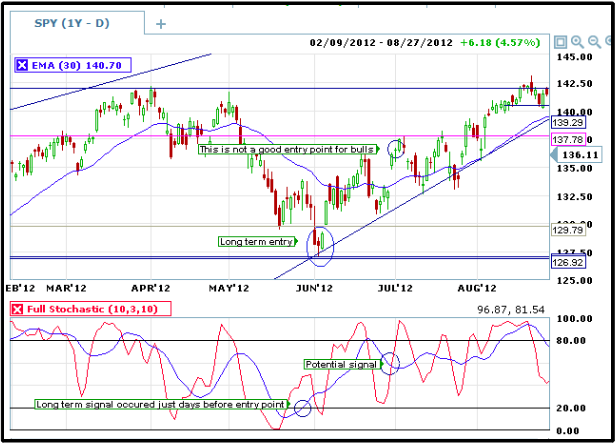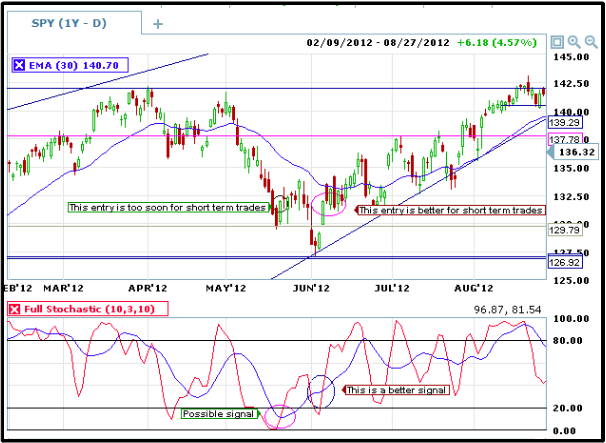Using Stochastics For Crossover Signals
Full Review of Stochastics for Crossover Signals in Binary Options
Using stochastic crossovers as a trading strategy is a risky undertaking. Stochastic is a popular trading tool but it is best used in conjunction with other indicators and not as a strategy all its own. As a trading strategy stochastic by itself leaves much to be desired but when incorporated with other tools in the trader’s toolbox can be an effective means of determining trend, entry points, support and resistance.
What Is Stochastics?
Stochastics is an oscillator tool similar to MACD and RSI. These tools measure market movement in a number of ways but all are focused on strength of direction over time. Oscillators usually move in a range that can be over and under 0 or between 0 and 100 as in the case of stochastic. As a stock moves upward the oscillator will move upward, trending in a fashion that mimics the movement of the underlying stock. Typically, oscillators can move within the range to positive and negative extremes in either bull or bear markets. What I mean is that an oscillator may retreat to a bearish extreme in a bull market or climb to a bullish extreme in a bear market. These moves to extreme levels are not signals of reversal but potential entry points in the underlying trend.
How Stochastic Works
Stochastic was created by a futures trader named George Lane. Because it is was designed for futures trading it is based on very short time frames which also makes it good for binary options trading. The methodology assumes that in an uptrend stock prices will close near the top of the day’s range and that in a downtrend prices will close near the bottom of the day’s range. The stochastic indicator uses two lines, %K and %D. %K is a measure of the day to day variation of stock closing prices. Since it so short term it is volatile and provides many false signals. The %D line is a smoothed version of %K and is more important, therefore earning the name of Signal Line. The math for the indicator looks like this:
C = Closing Price, L5 = the lowest closing price for the last five days and H5= the highest high for the last five days.
ñ %K = 100[(C-L5)/(H5– L5)]
H3= 3 period sum of (C-L5) and L3= three period sum of (H5– L5)
ñ %D = 100 (H3/L3)
The results, when plotted over time, are two lines that move between 0 and 100. The %K line can make detectable patterns but because of the volatility they are hard to read. The %D line smoothes out the data providing a signal line for the %K to cross over as well as providing signals of its own.
How to Use Stochastics for Crossovers
There are two primary methods for using stochastics crossovers in binary options. The first is when the %D line moves to an extreme, reverses, and then crosses back out of the extreme range. This is supposedly a sign of strength in a bull market and a sign of weakness in a bear market. A bullish crossover would be when %D moves below the bearish extreme and then crosses back over and the reverse in a bear market.
These signals, depending on the time frame of the chart you are looking at, can be longer term than you might be looking for. It can sometimes take 2 or even three crossovers before an anticipated movement actually happens…but this is the basis of a different technique that I will talk about in a future piece.

Longer Term Crossovers
In shorter terms crossovers are just what they sound like; one line crosses over the other. In this case it is the %K line crossing over the %D line. However, in order to use this technique you must first understand the underlying trend because using this technique to trade against the trend could result in huge losses. So, assuming the trend is bullish a crossover would be when the %K line moved below the %D line and then crosses back over %D. In a bear market a crossover would be when %K moves above %D and then crosses back under %D.

Shorter Terms Crossovers
Why This Technique Doesn’t Suck
This technique does not suck for one simple reason. It can provide reliable signals for entry in bull and bear markets. If you have correctly identified trend stochastic crossovers can be found in short, mid and long term charts and are especially strong signals when more than one time frame converge and give signals at the same time. Imagine the ocean during incoming tide and imagine that the long term trend is like that tide, slowly moving in. At some point the ocean, the wave and the ripple will all pull back simultaneously, just like the markets during corrections. This pullback opens a door for a new wave of investors to come in and make a higher mark on the shore. This is what a convergence of stochastic crossovers is like. It measures the waves and ripples in the market and when they converge it can signal an incoming wave of investors.
Why Stochastic Crossovers Suck
Stochastic crossovers suck because they are a lagging indicator and can produce numerous whipsaws if you don’t pinpoint your entry correctly. Crossovers can occur at any time and in any market. If you only rely on crossovers to provide your signals there is a good chance that you will miss out on large portions of the profits or could even lose money. Likewise, if a market is not trending strongly it is more likely that crossovers will be false signals and whipsaws.
The Last Word on Stochastic Crossovers
All in all I think stochastic crossovers are a good thing, especially when used in conjunction with other tools and techniques. I never rely solely on any one indicator or technique and like using stochastic. I will be keeping this weapon in my arsenal. There are other uses for stochastic as well that I will be exploring in future articles.
Keep Discussing this Indicator on our Forum!